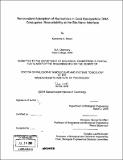Noncovalent adsorption of nucleotides in gold nanoparticle DNA conjugates : bioavailability at the bio-nano interface
Author(s)
Brown, Katherine Alice
DownloadFull printable version (17.75Mb)
Other Contributors
Massachusetts Institute of Technology. Biological Engineering Division.
Advisor
Kimberly Hamad-Schifferli.
Terms of use
Metadata
Show full item recordAbstract
The practical viability of biomolecule-nanostructure hybrids depends critically on the functional and structural stability of biomolecules in application environments. Noncovalent interactions of biochemical functional groups with nanostructure surfaces can significantly disrupt biomolecular structure and function. We report a systematic study of the effect of DNA sequence on the binding interaction between gold nanoparticles and thiolated DNA (AuNp-DNA). Base specific noncovalent nucleotide adsorption on gold surfaces can affect nucleotide bioavailability in solution. Systematic investigation of DNA oligonucleotide sequence, the location of specific sequence motifs, and the effect of nanoparticle size was performed. Sequence effects on DNA coverage and oligonucleotide adsorption affinities.were studied by Langmuir isotherm analysis. The nanoparticle coverage at saturating concentrations of thiolated DNA varied with oligonucleotide sequence. Saturation coverages correlated well with complement hybridization efficiency. From this we concluded that noncovalent interactions between nucleotides and the particle surface effect both hybridization and DNA coverage and adsorption. This hypothesis was confirmed by chemical treatment of the particle surface to eliminate noncovalent interactions. Upon treatment the effect of sequence on hybridization efficiency was removed. The effect of sequence is not consistent across nanoparticle sizes. Different bases show the highest saturation coverages and hybridization efficiencies on different AuNp sizes. These results allow for sequence selection guidelines based on AuNp size for sizes ranging from 4-11nm. For smaller particles (<5nm) adenine rich sequences show the highest saturation coverage and hybridization efficiency. (cont.) For mid-sized particles (~7.5nm), guanine sequences show the highest saturation coverage and hybridization efficiency. Larger particles (>10nm) show little sequence dependent behavior and are likely the best choice for uses where sequence choice is limited. Sequence selection based on these guidelines will provide AuNp-DNA conjugates with the highest possible oligonucleotide bioavailability, maximizing their utility in biotechnology applications.
Description
Thesis (Ph. D.)--Massachusetts Institute of Technology, Biological Engineering Division, 2008. Includes bibliographical references (p. 82-92).
Date issued
2008Department
Massachusetts Institute of Technology. Department of Biological EngineeringPublisher
Massachusetts Institute of Technology
Keywords
Biological Engineering Division.